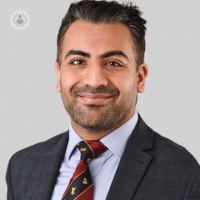Should I be concerned about my baby's umbilical hernia?
Written in association with:For parents, the idea of their baby having an umbilical hernia is a cause for concern. Respected consultant paediatric surgeon Mr Hemanshoo Thakkar explains what an umbilical hernia is, how parents can recognise them and what action to take to resolve them.
What is an umbilical hernia in infants, and what causes it? Are there any risk factors associated?
An umbilical hernia is essentially what we call a defect, or a weakness in the muscle that develops around the belly button. When babies are in the womb, during development, they’re being fed through the umbilical cord.

The umbilical cord usually detaches itself in the first few days after birth and in that area, there is a little muscle we expect to close. If the muscle doesn’t close, a small weakness is left i.e. an umbilical hernia. Umbilical hernias are very common. Statistics demonstrate that 10-20% of babies can have umbilical hernias at birth but by the time they reach the age of one, that figure drops to anything between 2 to 10%.
These hernias typically tend to start to disappear as the baby gets older. There are some particular populations, such as Afro-Caribbean races, whereby the resolution rate is a little slower, and sometimes in these particular ethnicities, it doesn’t slow at all. These cases are ones which we would typically go on to repair surgically.
How are umbilical hernias in children diagnosed? How can parents recognise them?
Umbilical hernias are seen quite easily on your baby. Typically you would see them crying and distressed because they are experiencing raised, intra-abdominal pressure, meaning that the intestine, which is normally sitting in the abdomen, will start to protrude through this tiny little defect, which is on the baby’s tummy.
As a result, you will often see a bulge in that area, which becomes more apparent when a baby is distressed. At other times, when your baby is not distressed, it will often disappear and you will notice a pattern of the bulge coming and going in that area.
It can be easily seen and doesn’t require diagnosis through a scan. An umbilical hernia can be detected through a clinical examination, such as with a general practitioner or a paediatric surgeon.
When should I worry about my child's umbilical hernia?
In most situations, umbilical hernias do not cause any symptoms. They mainly cause a visible bulge in that area. Sometimes parents will report to us that their child is having abdominal pain in relation to an umbilical hernia, but more often than not we tend to find that there are other reasons for this pain, rather than the umbilical hernia itself.
Typically, what happens is that the intestine (which is in the abdomen) passes in and out of the defect. When the defect is present, it is extremely rare for the bowel to become trapped or stuck in that area. If it does become trapped, it will cause a lot of pain, redness, and swelling, and affect the way your baby is feeling and feeding.
If that were to happen, before the time your baby went on to have a repair or if they were just under observation, we would always recommend an emergency visit to the A&E department to be assessed. However, in my experience, it is highly unlikely that this would occur.
When is surgical intervention recommended for an umbilical hernia in infants? What factors determine the need for surgery, and what does the procedure involve?
We normally follow most of our patients at least up until the age of three before we would consider any surgery and more often than not, most paediatric surgeons will allow the period even up to the child’s fifth birthday to see whether or not the hernias will close. For many patients, they will close, and as a result, we do not normally recommend having surgery before that age.
If the hernia is still present after the age of 4-5 and if the size of the defect is large with a visible bulge, we would recommend having surgery. The surgery is usually performed as a day case, with the intention for the baby to go home the same day. It involves a general anaesthetic, meaning that the baby would be fast asleep. We would typically make a small cut in the area where the umbilical hernia is.
Following this, we would search to identify the sac (the tissue around the abdomen) which is allowing the bowel to protrude through. After finding the sac and identifying exactly where the hernia is, it is then trimmed so that we can get down to the level of the healthy muscle. We would then put in stitches and close the hernia defect.
Subsequently, the skin and surrounding fatty tissue are closed. Some surgeons will leave a dressing on top of the umbilicus, to prevent any fluid accumulating. Furthermore, in the majority of situations, we would add local anaesthetic to try and numb the pain after the operation.
After wakening, we would expect the child to be able to eat and drink immediately and go home a few hours later.
Are there any complications associated with an umbilical hernia in infants? If so, what are they and how are they managed?
In terms of the surgery, we would always mention a very small risk of bleeding or infection.
The risk of bleeding is not so high that we would recommend any routine pre-operative blood transfusion and the risk of infection is low so we wouldn’t routinely use antibiotics.
The other risks are those which are inherent to the operation. During the surgery itself, because the intestine is very close to where we are operating, there is a technical risk of causing harm or damage to the bowel. If that were to happen, we would treat it and inform you as a parent of any injury. However, the chance of this happening is extremely slim.
In addition, there is a small chance that after the hernia repair itself is completed, a seroma or a haematoma can develop, which is when either fluid or blood accumulates underneath the skin. These can occur in cases where hernias are large and there is a lot of redundant space in the area of the hernia.
When the muscle is closed, there may be some excess skin, with an accumulation of fluid underneath. Many surgeons will mitigate against this by putting a special dressing on called a pressure dressing, which is left in place just to prevent fluid from accumulating, typically for 2-3 days.
Furthermore, there is a longer-term risk of the hernia coming back. I would normally report rates of anything between 1-2% (closer to 1%) of this occurring; it is highly unlikely.
If you are concerned that your child has an umbilical hernia and would like to book a consultation with Mr Thakkar, do not hesitate to do so by visiting his Top Doctors profile today.


